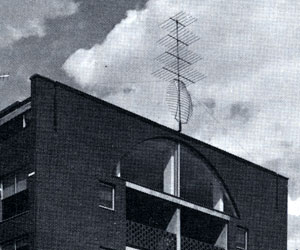Ether 12 Ugly and Ordinary

 For the most part, One Wilshire is an ugly and ordinary building, akin to the now classic post-modernist retirement home, Guild House. In designing Guild House, Robert Venturi and Denise Scott Brown decided to avoid the monument and instead build a structure more appropriate to the banal demands of modern life. Cut-rate detailing and low-cost prefabricated elements made Guild House a stark reminder that modernism won its battle not because of ideology but because it was cheaper to build than neo-classicism. Later projects by the firm that followed this methodology would be condemned as “ugly and ordinary” by Skidmore Owings and Merrill’s lead designer Gordon Bunshaft. Venturi and Brown adopt Bunshaft’s term as a virtue, countering that “ugly and ordinary items in culture represent the democratic segment of society, as they embody mass consciousness.”
For the most part, One Wilshire is an ugly and ordinary building, akin to the now classic post-modernist retirement home, Guild House. In designing Guild House, Robert Venturi and Denise Scott Brown decided to avoid the monument and instead build a structure more appropriate to the banal demands of modern life. Cut-rate detailing and low-cost prefabricated elements made Guild House a stark reminder that modernism won its battle not because of ideology but because it was cheaper to build than neo-classicism. Later projects by the firm that followed this methodology would be condemned as “ugly and ordinary” by Skidmore Owings and Merrill’s lead designer Gordon Bunshaft. Venturi and Brown adopt Bunshaft’s term as a virtue, countering that “ugly and ordinary items in culture represent the democratic segment of society, as they embody mass consciousness.”
Choosing to strike preemptively against the ill-suited signage that clients inevitably put atop modernist buildings, Venturi and Scott Brown added their own sign to announce the structure’s name: a second-rate panel that simply states “Guild House” above the entrance. At the top of the building the architects also mounted a non-functioning, gold anodized antenna to mark the building’s common room and to signify that the elderly watch a lot of TV. Seen by both critics and occupants as a cynical joke at the expense of the inhabitants, this useless antenna was later removed.
The removal of the antenna was not, however, a fatal blow. Venturi and Scott Brown observed that the ability to remove or replace signage at will gave flexibility to structures. Upon returning from a research trip to Las Vegas, the architects coined the term “the decorated shed” to refer to a modernist universal space coupled with a sign. In the decorated shed both function and meaning could be changed at will. Although Guild House is held by many to be a key building in the evolution of postmodernism, the ideas of the decorated shed and ugly and ordinary architecture proved too controversial for even the most avant-garde architects and Venturi and Scott Brown were virtually ostracized from the profession.